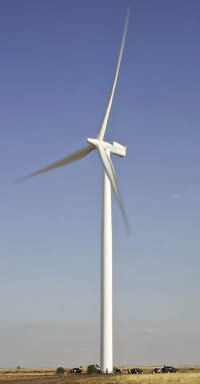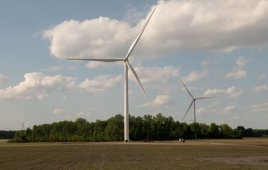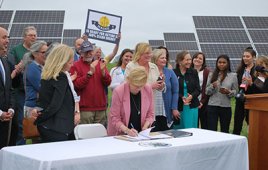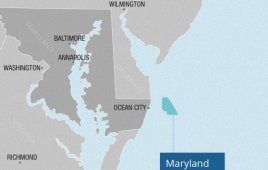The U.S. Department of Energy’s National Renewable Energy Laboratory (NREL) and Siemens Energy Inc. have formally commissioned a 2.3 MW Siemens wind turbine at NREL’s National Wind Technology Center. The turbine is the centerpiece of a multi-year project to study the performance and aerodynamics of a new class of large, land-based machines in a program that will be the biggest government-industry research partnership for wind power generation ever undertaken in the U.S. For that commissioning and duty, the Siemens 2.3 unit is Windpower Engineering’s Turbine of the Month.
The turbine is said to mark the start of a new era of research at NREL’s Wind Technology Center, according to Director Dan Arvizu. “We will embark on a R&D program that will pave the way for more advanced wind turbines,” he said. Under the R&D agreement, the two organizations will test basic turbine characteristics and verify new performance-enhancing features of the pilot turbine over at least three years. Testing will include real-world operating conditions, including severe weather. Under the initial phase of the $14 million research program, Siemens will contribute $9 million and NREL $5 million.
“This research program will help us further enhance the performance of our turbines and lower the cost of clean, wind-generated power, which in turn will help diversify the overall mix of power generation sources in the U.S,” says Siemens Energy’s VP Barry Nicholls.
The 2.3-MW unit is among the largest land-based turbines deployed in the U.S. and is the largest at the Technology Center. Testing will examine structural and performance characteristics, aerodynamic and performance improvements, along with model, acoustics, and power-quality studies. The turbine is fitted with a 101-m diameter rotor (331 ft) and mounted atop an 80-m tower (262 ft).
NREL researchers also are interested in the below-ground structures (foundations) required to support such large turbines. NREL and wind-plant developer Renewable Energy Systems Americas (RES), Broomfield, Colo., (res-americas.com) have agreed to study the design and performance of turbine foundations, with goals of increasing the reliability of non-turbine components and reducing turbine installation costs.
“RES Americas installed several types of instruments to monitor foundation response to operating turbine loads,” says RES Civil Engineering Manager Jomaa Ben-Hassine. “Instruments include earth pressure cells that measure contact pressure between the foundation and the supporting soils, strain gages attached to select rebar to measure foundation stresses, and anchor- bolt load cells that measure anchor bolt tension. The goal of the two-year study is to gain a better understanding of foundation response and identify areas where the design performance and economy can be improved,” he says.
A new meteorological tower to the west of the test turbine will feature more than 60 instruments to collect the most advanced data available on wind, temperature, dew point, precipitation and other weather features that can influence the performance and lifespan of a wind turbine.
What’s more, the new turbine and other new projects underway at the Tech Center let NREL take a step forward in generating its own electricity to accomplish the laboratory’s aggressive goals while meeting the energy needs of NREL’s expanding campus. In addition, the DOE and Xcel Energy are negotiating an agreement to sell surplus energy to the local utility grid.
Filed Under: Uncategorized






The fallacy with wind power is the rated power versus actual output. Rated 2.3 MW is great, but when the overall utility factor is 22%, then you’re only getting 4,433 MWh/yr of generation. It sounds like a lot, but at commercial 5 cents/kWh, it’s only $200k/year in revenue. A 2.3 MW the system will cost $5.75m installed, so it will take 29 years to pay off without tax benefits and government incentives. The only guys making money on this deal are the Germans. So why are we paying for their development and testing?
We need an order of magnitude improvement in wind-power technology, which is what our team is working on.
I am reading that the current trend in wind generators is direct drive synchronous PM because it eliminates the transmission because of high pole configuration.
One problem with the direct drive PMSM is the voltage control, I am interested in any advacement with direct drive systems and any technology addressing the voltage control.
Dear Electriclouie:
NREL does some work in that area, as does Northern Power, in Vermont. Several new turbines (from GE being one) will be direct drive to get around generator problems, but as you suggest, that introduces design challenges of larger generators.
Paul Dvorak
The Siemens 2.3-101 is the best wind turbine ever built. Surely new designs from Siemens will soon surpass this beauty but for now it is king.
Mr. Hawkins:
I’ll take your word for it. However, all turbine designs are changing fast so that today’s leader could be tomorrows laggard. It seems to me that the industry has been constant in its favorite design for a while (horizontal axis, three blades, on tall towers). One crazy successful idea could upset the whole applecart. (Magenn, Nova?)
Paul Dvorak
Three things. How did a German COmpany end up in a partnership with the US Government? Why wasn’t an American Wind Turbine Manufacturer chosen. Aren’t we trying to create Green jobs in the US?
Second, I agree that there is no polution from generating wind power. There is one problem, since wind is not predicable the natural gas or steam turbines continue to run and create emissions. Wind power is not replacing traditional generation completely.
Third, Wind electricity is cheaper because of Feed In Tarriffs and Government incentives. Once they are gone I am not sure that it will remain cheaper especially because of wind predictability.
With the advancement of technology, harnessing wind energy has become easy. Though the initial cost of setting up a wind turbine may be more it still has numerous benefits. There is no pollution, no burning of fossil fuels and saves electricity bills. Pacific Crest Transformers is one company that has been working closely with the wind energy sector and promoting clean energy in the US. It has more on the smart system and its role in the energy grid. http://pacificcresttrans.com/home.html